Skiing to me has always been spiritual. A ski area is supposed to be like a cathedral carved into the mountains. It’s not the amenities or ease of access that draw me back. It’s the feeling I get from the place — the aura it exudes. The history of skiing and snowboarding there, the scenery, the road that leads to it, and the people it attracts. The list of “churches” of skiing and snowboarding in my heart is short, and one of those is Wolf Creek Ski Area.
How I Found Out About Wolf Creek
Instead of spending money on things for us, my mom and dad invested in road trips, crafting itineraries that exposed us to natural beauty, history, and culture. It was on one of these trips, in our trusty 1985 Suburban, that we pulled into Pagosa Springs in the summer of 1992. The next morning, we woke up, sauntered into a breakfast spot, and walked past a kiosk filled with flyers. One in particular caught my eye: “Snowiest Ski Area in Colorado.”
I picked it up and devoured all the information on it. I had heard of places like Vail and Aspen, but Wolf Creek? Even my dad, who skied Colorado in the ’60s, had never heard of it. I had just barely started snowboarding—if you can call it that, with a Black Snow—but this flyer was burned into my brain. Nearly thirty years later, I made my return.
Why We Love Wolf Creek

Wolf Creek is an explorer’s mountain. It’s not a place to race through vertical like Sun Valley or to scope out runs from the lift like Kirkwood. On the surface, Wolf Creek might seem like a flat mountain, and many people will say that—let them.
From the parking lot, it hints at the fun to be had. But Wolf Creek won’t reveal its secrets without some effort. You need to explore its nooks and crannies or have a local show you how to connect steep shots into one continuous line from top to bottom. And you’ll need to earn your turns by hiking to access its steepest terrain—and its FREE snowcat. If you’re looking for a slower-paced destination with nonexistent lines and mountain adventure, you’ll love Wolf Creek.
Remembering Why Colorado Snow is Famous
I haven’t been back to Colorado since 2003, and the first few runs at Wolf Creek reminded me of something I had forgotten about Colorado skiing. While Tahoe’s mountains get feet of snow, the Maritime snowpack firms up quickly. Despite Wolf Creek not having had snow for a week, it felt chalky and edgeable—a joy to easily lay a perfect carve into. I could imagine my dad smiling from above and saying to me, “Colorado skiing isn’t a fight, but a relaxed stroll through the mountains.”
The Stats
Vertical: 1,604 feet
Base: 10,300 feet
Summit: 11,904 feet
Skiable Acres: 1,600 acres
Snowfall: 430+ inches
Trails: 133
Terrain
As you crest over Wolf Creek Pass and make the sweeping right turn from Pagosa Springs, the mountain reveals itself. A massive horseshoe-shaped bowl, as far as the eye can see, is all accessible and inbounds. Similar to Mount Baker’s location, its shape acts like a catcher’s mitt for approaching storms, helping it receive the most snow in Colorado. The mountain’s terrain difficulty flows naturally from looker’s right to left, with the easiest terrain on the right, progressively getting more challenging as you move left.
Beginner
First-timers should focus their time around the base area. The Tumbler beginner area in particular is a good spot to learn without the pressure of experts zipping by, since it’s separated from the rest of the mountain. As beginners gain confidence, they can graduate to the Raven Chair, starting off with Bunny Hop and then moving skiers right to Snow Shoe, Thumper, and so on.
Intermediates
Intermediates have access to almost any lift and can easily avoid the more challenging terrain. That said, the largest selection of intermediate runs is found off the Treasure Stoke and Bonanza chairs. Off the Treasure Stoke, Tranquility is a fun, rolling, and yawing trail with a nice pitch, perfect for laying down trenches if you’re in the mood.
Experts
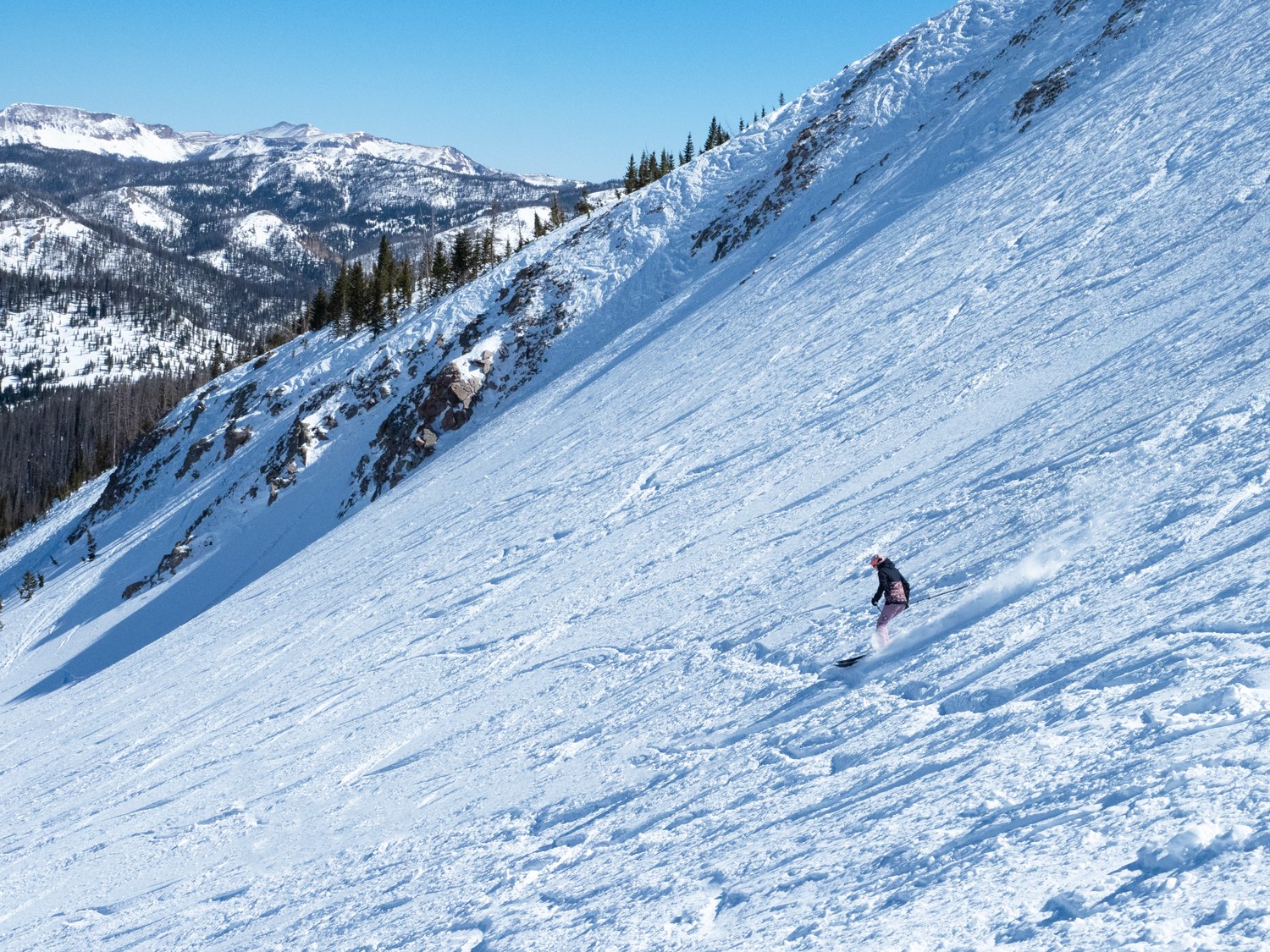
The steepest terrain at Wolf Creek can be found along the top of the ridgeline, but you can also connect these upper segments to other fun, steep pitches such as the Waterfall Area. Tucked in that zone, you’ll find plenty of cliffs to huck and chutes to navigate. For a quick hit, the Alberta Face right under the Treasure Stoke lift offers about 500 vertical feet of uninterrupted fall-line skiing.
If it hasn’t snowed in a few days, your best bet to find pow stashes is by throwing your skis on your back and doing a bit of hiking to Montezuma Bowl, which funnels into another zone called the Pitch, featuring some fun, steep glades. Or you can make the climb up Knife Ridge (more on that below), which gives you access to Coyote Park, which then trickles into Keith’s Glades.
Knife Ridge – My Most Embarrassing Moment
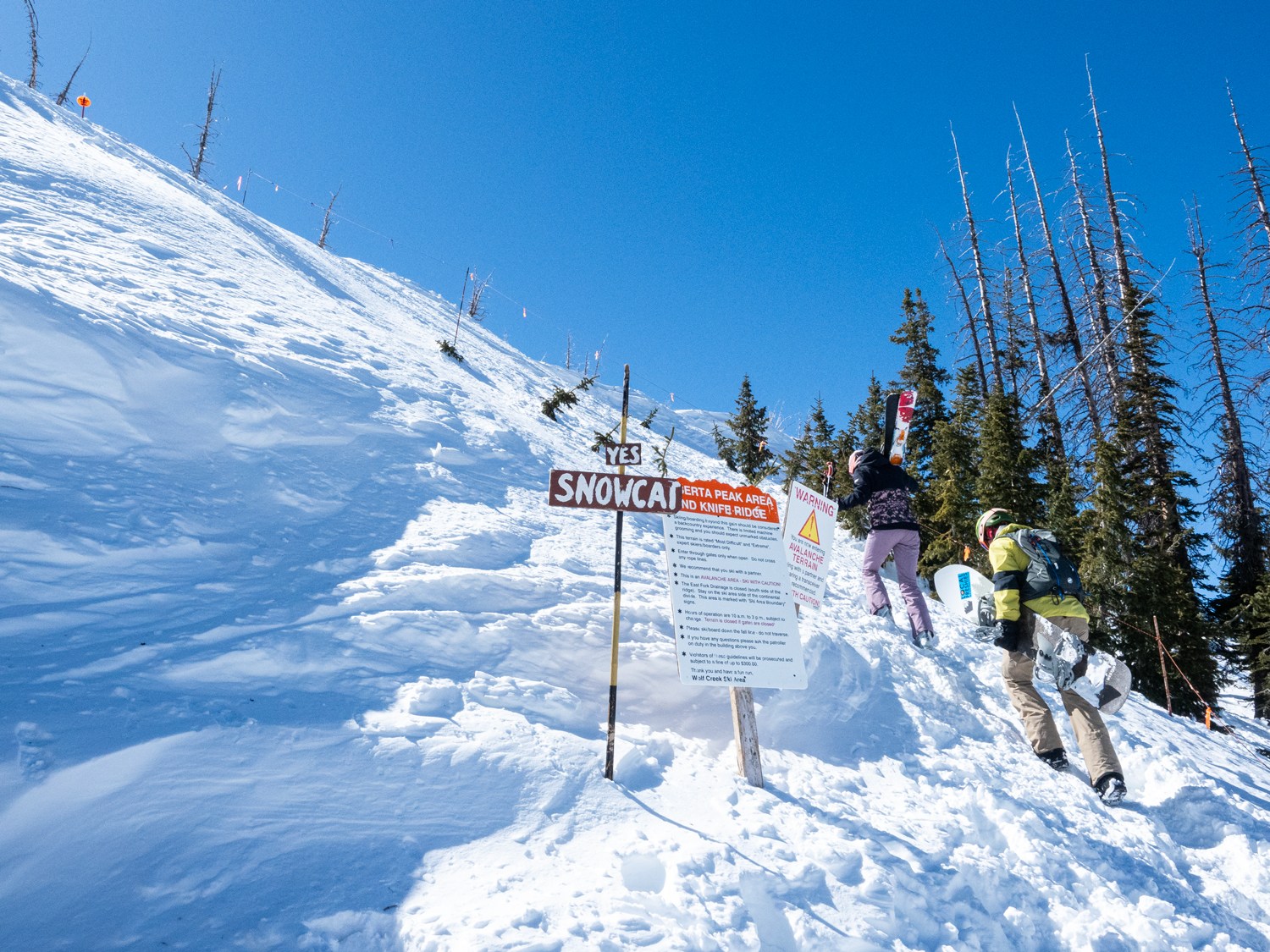
Out of any part of the mountain, “Knife Ridge” is the most unique and aptly named. To access it from the top of the Alberta Lift, you need to unstrap (or unclip) and hike up the steep face to the ridgeline. Like a roller coaster, this footpath gives you a small taste of what to expect. As you shuffle past the ski patrol shack, the ridgeline drops on one side, with what feels like 1,000 feet below. On the left, a stand of trees offers protection. Continuing onward, you climb a metal staircase built into the cliff.
What Have I Gotten Myself Into?
That’s when my nerves began to fray. My fear of heights started to bubble up. The metal staircase transitions into a metal bridge that spans a twenty-foot expanse. As we step across it and continue our ascent, we reach another set of metal stairs. Each step makes a loud tinging sound, and thoughts of the spaceship from the movie Aliens crawl into my head. We crest over the final pitch, and the guardrails disappear. All that’s left is a razor-thin ridgeline, maybe five feet wide. On each side, it drops at least 500 vertical feet. I look down to my left and see small skiers gliding past. I’m paralyzed with fear.
Shame and Embarrassment
What should I do? I lose focus. I can’t let this beat me. Inhaling a calming breath I take one step and freeze. Suddenly, I drop down onto the ground and crawl, hugging the earth. For fifty feet, I’m terrified… and embarrassed. As I finish this segment, I feel ashamed. After all this mental degradation, we find the deepest snow on the mountain. It was well worth the effort but emasculating at the same time. In the end, I vow to return and conquer my personal fears.
Goat Tracking is Frowned Upon
Throughout Wolf Creek, you’ll see stickers plastered around saying “No Goat Tracking.” Since I had never heard the term before, I asked Erika, the daughter of the owner. She explained that it refers to skiers and snowboarders creating traverses to access a bowl or chute (like goats), instead of using a cat track or hiking over and then skiing the fall line. Locals can’t stand it because multiple traverse lines can ruin the run, and you could potentially cut off skiers who are skiing fall line.
A Taste of Europe

Sometimes you need a caffeine pick me up. The Continental Espresso Bar located a short jaunt from the summit station of the Treasure Stoke chair is then what you needed. This cozy chalet features large windows providing nearly 360 degrees views of the big peaks surrounding you. The modern concrete structure with large wooden pine beams makes it feel as though you stepped into a portal and are suddenly sipping on a cappuccino somewhere in the Alps.
When to Go
While Arapahoe Basin and Keystone are usually the first to open in Colorado, it’s typically with the help of snowmaking and usually just one trail. Snow comes early to Wolf Creek, with most winters allowing them to open a handful of trails on real snow by the end of October. If you want to access the entire mountain, it’s a good idea to wait until more storms arrive. In an average winter, it’s a safe bet that by mid-December, prior to the holidays, you’ll find deep snow and uncrowded slopes. January through March are also great times to visit, but be aware that most of their skiers come from Texas and Oklahoma, so it’s important to consider those states’ school schedules. This can be easily identified based on Wolf Creek’s Peak Dates:
Dec 22-24, 26-31
Jan 1-4, 18-19
Feb 14-16
Mar 9-15
Where to Stay
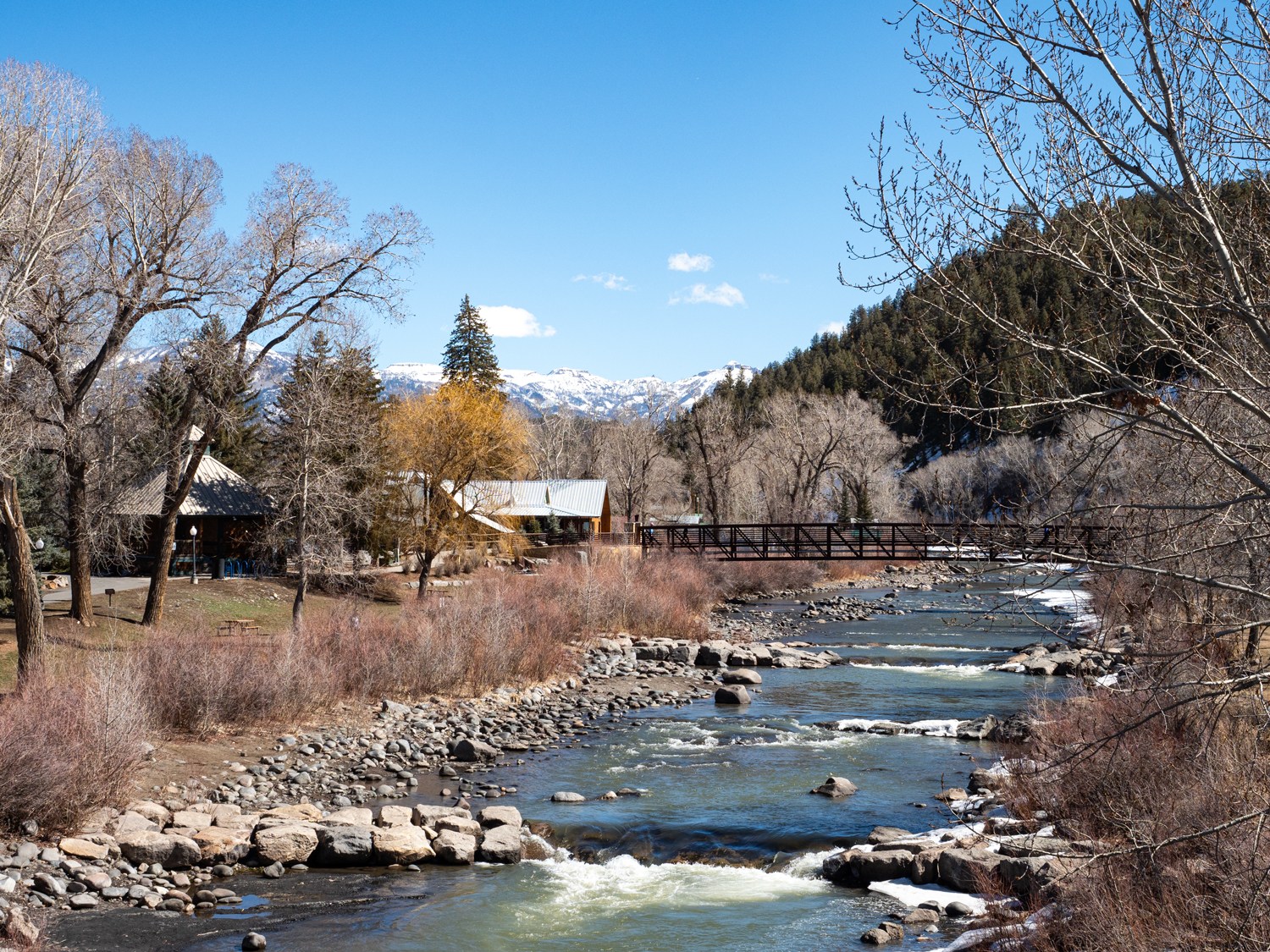
There is no onsite lodging at Wolf Creek Ski Area, so you have two options: either stay in the town of South Fork or Pagosa Springs. Erika mentioned that South Fork is a good choice if you want a straight shot with less challenging roads to drive. For a more immersive experience, including hot springs, plenty of dining options, and a fun little downtown, Pagosa Springs is the one we’d pick.
Back in 1992 when we visited, the Springs Resort & Spa was affordable, but since then, it’s gone through several renovations and now offers a high-end spa experience that’s out of our price range. Instead, we stayed at Healing Waters across the street. Their rooms are massive, and the hotel has its own rejuvenating hot springs pool as well. While not as fancy, it’s a fraction of the cost.
Would We Go Be Back?
Getting here is a challenge—nearly 4.5 hours from Denver and 3 hours from Santa Fe. There are larger mountains closer to major airports, like Aspen or Vail, that offer luxurious, all-inclusive vacation experiences. If you’re looking for scare your pants off steeps even Taos is easier to get to.
Countless reasons not to come.
But that’s why we love it and why we’d DEFINITELY go back. Why? They’re about the skiing first and foremost. Instead of focusing on the real estate play or filling shareholders pockets, they’re putting the money back to make the experience on the slopes better by keeping their low ski density experience.
Second, Wolf Creek’s website said it best. It’s because it offers an “inbounds backcountry experience.” If you stay on its main trails you’ll get bored easily but its soul is in its off-piste terrain. Don’t just follow the skier in front of you. Climb up Knife Ridge. Ride over to Horseshoe Bowl. Hike over to Montezuma Bowl.
Wolf Creek lives by John Muir’s mantra, “Between every two pine trees there is a doorway to a new world” and that’s what makes it magical.





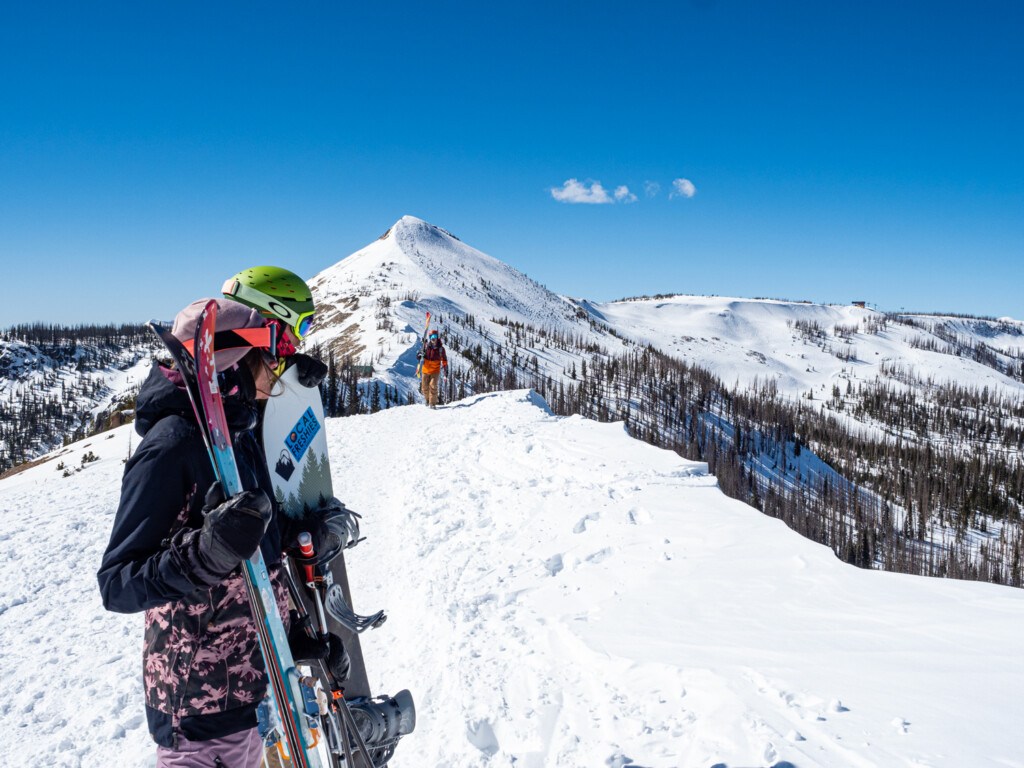

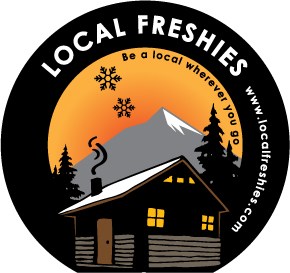
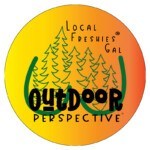
This is my sorta home mountain, not just because I will teach there but because it reminds me of the places I started skiing at. From Kelly Boyce and Bunny Hop to the Alberta Peak and between you can get lost there. But from beginner to expert you can find it all. With the new Nova chair and the exciting magic tube beginners can feel safe to find their groove. For those looking for entertainment try zipping around off the Bonanza lift. Lots of pow lines and some entailing bump runs on Thumper. But the real thrill is off Alberta. Jump off the cliff into steep and often soft powder. Look for the unofficial snow stake. Send me a picture when you find it.